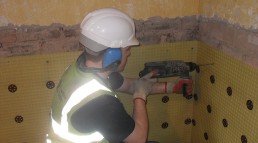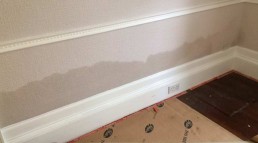Since 1875, damp proofing has been implemented into property builds and has become a requirement in construction of new buildings to prevent rising damp. A damp proof course is typically 150 mm above ground level and is formed by a membrane built into the walls of a property. However, sometimes the damp can still penetrate or rise into your home, displaying ‘tidal’ marks, damp patches, and signs of timber decay.
Knowing what to look for can be difficult, which is why we have professional damp specialists on hand to identify the issue and apply the most suitable treatment based on your property and current regulations. We are going to explain the different types of damp proof course available, and the scenarios where you might need to apply one.
What is a Damp Proof Course?
A damp proof course is a long-term rising damp stopping membrane built into a wall just above ground level developed in the Victorian era designed to prevent damp rising from the ground and affecting the property. New buildings, both domestic and commercial, now require the protection of a damp proof course barrier when they are initially constructed.
Damp proofing can be formed by both a damp proof membrane and a damp proof course, or by using both treatments together. A damp proof course is typically found 150 mm (6 inches) above ground level which was formed in older properties with slate or bitumen sheet and in modern properties with plastic sheet. If a property does not contain a damp proof course, it can be created by injecting a damp proofing material within the wall forming a new damp proof course.
Property renovations that raise the ground level above the current damp proof course are a common reason why damp occurs. If left untreated it will lead to rising damp in walls and damaged internal decoration. In more severe cases, rising damp can cause floor joists to rot and create additional issues requiring further treatment solutions.
Our specialist damp surveyors can conduct damp surveys and identify the best course of treatment to rectify any damp problem present in your property. We would always recommend that you have your damp proof course inspected as soon as you notice a problem.

Different Types of Damp Proof Courses
There are a number of damp proof courses available, but the most appropriate method depends on the type of property requiring treatment:
Damp Proof Injection – silicone-based liquid or cream injected into the wall, no less than 150 mm from the base, to provide a water-repellent layer. This is often the most practical solution requiring minimal disruption to the property.
Electro+ Osmotic Damp Proof Course – most appropriate for older buildings with thick, stone-rubble-filled walls. A positive electric charge is used to drive water back down to the ground.
Damp Proof Cream – a versatile treatment that is suitable for any type or thickness of wall. It works by utilising a chemical reaction that forms a water-repellent in the masonry when it reacts with moisture.
Damp Proof Membrane – a damp proof membrane made of polyethylene or butyl can be applied to the inside of the property, creating a damp proof layer. This not only protects the interior decoration but helps the wall to dry out quicker. At Richardson & Starling, we sometimes use a combination of a damp proofing membrane and chemical damp proof course to provide the best possible treatment solution. All our injected damp proof course treatments come with a 30-year damp proof course guarantee.
Do All Properties Have A Damp Proof Course?
Damp proofing was first introduced in the late 19th century but was mainly unreliable. Today, damp proof courses are required in contemporary properties and still use the same methods that were first implemented in the 1970s.
Over time, as properties settle and move or the existing damp proof course is bridged then this may allow moisture to begin moving upwards. It is therefore important to check for signs of damp around the home, particularly on the lower half of the walls, as this can indicate that the damp proof course is not working.
Taking immediate action when faced with damp is vital, as damp that is left untreated will spread with time and can cause timber decay, such as dry or wet rot, which can lead to significant structural damage to your property. Degradation of plaster and decorative finishes, along-side tidal-mark stains can be a few of the internal symptoms of damp.
Most homes will have a damp proof course, but even if they do, they can get damaged and then become susceptible to damp. Our damp specialists can help you to identify damp early and provide both the right diagnosis as well as the most effective treatment solution.
What Causes Damp Walls?
The first step in fixing damp walls is identifying the source. Rising damp, Condensation or Penetrating damp caused by rainwater from defective roofing, leaking gutters, faulty downpipes defective masonry, vegetation, and roots damaging foundations, to defective sealing of windows and doors or defective cavity wall insulation. It can be difficult to pinpoint the exact source of damp walls. Booking a damp survey will help you to identify exactly what is causing the issue.
If you experience wet, damp, or cold walls, wet patches or black mould, these may be initial indicators of rising damp, penetrating damp or condensation. You can identify damp initially by resting the back of your hand on the wall to feel the damp however, a damp meter should be used to determine that high moisture content is present and in what areas of the wall.

Whether internal or external issues are causing damp, you will experience damp in one of three ways:
- Condensation on walls – typically condensation and black mould issues are caused by high moisture content in the atmosphere from everyday activities such as showering, cooking, or drying clothes indoors. In other cases, the cause of condensation might be damp cavity wall insulation or other structural defects that create cold spots within your walls. Condensation can also be caused by poor ventilation in your property.
- Rising damp on walls – this only affects ground-floor walls and often appears as discoloured tide marks up to 1 metre in height, bubbling plaster or decoration and is caused by a defective damp proof course.
- Penetrating damp on walls – this is caused by defects in your property causing damp to penetrate the property. Porous masonry, damaged rainwater goods and damaged roofing can allow rainwater to penetrate the exterior and affect the fabric of your property.
What to Do Next?
If you are concerned that you have an initial onset of damp in your property, it is important to get this problem assessed by a professional as soon as possible. At Richardson & Starling, our PCA accredited specialist damp surveyors can help you identify the cause of damp in your home and determine a remedy specific to your property to deal with the damp problem. If you have any questions about damp or if you would like to book a survey, please contact your local branch who will be happy to help.